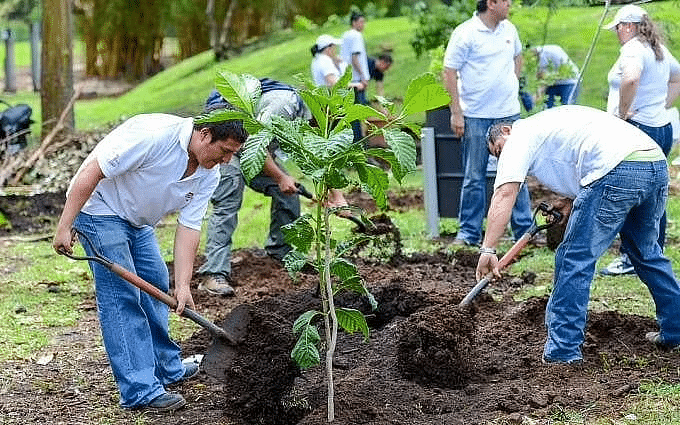Conservation of Plants and Animals Class 8 Notes Science Chapter 5
Conservation of plants and animals is essential for maintaining biodiversity, ecological balance, and the overall health of the planet.

- The chapter "Conservation of Plants & Animals" highlights the importance of preserving our natural environment, focusing on the need to protect the rich biodiversity of plants and animals.
- As human activities continue to threaten ecosystems through deforestation, pollution, and habitat destruction, the chapter discusses the vital role of conservation efforts in maintaining ecological balance.
- It explores various methods of conservation, including the establishment of wildlife sanctuaries, national parks, and biosphere reserves.
Deforestation and Its Causes
Many different kinds of plants and animals live on Earth, and they're really important for humans. However, a big problem threatening them is deforestation, which means cutting down forests for things like farming, and building houses.
Trees in the forest are cut for some of the purposes mentioned below:
- Procuring land for cultivation.
- Building houses and factories.
- Making furniture or using wood as fuel.
- Some natural causes of deforestation are forest fires and severe droughts.
Sometimes, natural events like forest fires or long periods without rain also contribute to deforestation.

Consequences of Deforestation
Deforestation is when large areas of forests are cut down or removed.

This is a big problem because it causes a lot of problems for the environment, climate, animals and plants, and people's well-being. some of the consequences of deforestation are:
- Deforestation increases the temperature and pollution level on the earth. It increases the level of carbon dioxide in the atmosphere.
- Groundwater level also gets lowered.
- Deforestation disturbs the balance in nature. If the cutting of trees continues, rainfall and the fertility of the soil will decrease.
- Moreover, there will be increased chances of natural calamities such as floods and droughts. Plants need carbon dioxide for photosynthesis.
- Fewer trees would mean that less carbon dioxide will be used up resulting in its increased amount in the atmosphere.
- This will lead to global warming as carbon dioxide traps the heat rays reflected by the earth.
- The increase in temperature on the earth disturbs the water cycle and may reduce rainfall. This could cause droughts.
- Deforestation is a major cause that leads to the change in soil properties. The physical properties of the soil get affected by plantation and vegetation.
- Deforestation also leads to a decrease in the water holding capacity of the soil.
- The movement of water from the soil surface into the ground (infiltration rate) is reduced. So, there are floods.
Two major Consequences of Deforestation
(a) Desertification- Desertification transforms fertile land into a desert-like environment.
 Desertification
Desertification
- When trees and plants are removed, the soil loses its moisture and fertility, resembling the removal of a natural protective blanket.
- Without this cover, the soil erodes, becomes arid, and unsuitable for cultivation, gradually resembling a desert landscape.
(b) Droughts
- Droughts happen when there is not enough rain for a long time.
- This makes it difficult for plants, animals, and people to get the water they need.
 Drought
Drought
- It can affect farms, making it hard to grow crops.
- It also means less water in rivers and lakes, which can cause problems for communities.
- Droughts can have a big impact on the environment and make it challenging for everyone to have enough water.
Conservation of Forest and Wildlife
Conservation of wildlife and forests is important for maintaining ecological balance, biodiversity, and the overall health of the planet. Here are key aspects and strategies associated with the conservation of wildlife and forests:
One of the primary goals of conservation is to protect and preserve the natural habitats of various species. This involves safeguarding forests, wetlands, grasslands, and other ecosystems that support wildlife.
1. Wildlife Sanctuary
Purpose: Protection of animals and their habitats.
Prohibitions: Activities such as plantation, cultivation, grazing, felling trees, hunting, and poaching are prohibited to minimize disturbance.
2. National Park
Purpose: Reservation of areas for wildlife, allowing animals to freely use habitats and natural resources.
Emphasis: Providing a space where wildlife can thrive without significant human interference.
Biosphere Reserve
Large areas of protected land for conservation of wildlife, plant and animal resources and traditional life of the tribals living in the area.
 Pachmarhi Biosphere Reserve
Pachmarhi Biosphere Reserve
- Biosphere reserves are the areas meant for the conservation of biodiversity. Biodiversity is the variety of plants, animals, and microorganisms generally found in an area.
- The biosphere reserves help to maintain the biodiversity and culture of that area. A biosphere reserve may also contain other protected areas in it.
- The Pachmarhi Biosphere Reserve consists of one national park named Satpura and two wildlife sanctuaries named Bori and Pachmarhi.
Flora and Fauna
The terms "flora" and "fauna" are used to describe the plant and animal life in a given geographical area, ecosystem, or region.
- Flora: This term encompasses all the plant species in a specific area. It includes trees, shrubs, grasses, flowers, and other types of plant life.
- Fauna: Fauna, on the other hand, refers to the animal life present in a particular region. It includes mammals, birds, reptiles, insects, and any other form of animal life.

Examples of Flora
Sal, teak, mango, Jamun, silver ferns, Arjun, etc

Examples of Fauna
Chinkara, blue bull, barking deer, cheetah, leopard, wild dog, wolf, etc.

Endemic Species
Endemic species are those species of plants and animals which are found exclusively in a particular area. They are not naturally found anywhere else.
- A particular type of animal or plant may be endemic to a zone, a state, or a country. Sal and wild mango are two examples of endemic flora. Bison, Indian giant squirrel, and flying squirrel are endemic fauna.

- The destruction of their habitat, increasing population, and introduction of new species may affect the natural habitat of endemic species and endanger their existence.
Wildlife Sanctuary
Wildlife Santuaries are the protected areas that provide protection and suitable living conditions to wild animals. Sanctuaries are places where killing (poaching) or capturing of animals is strictly prohibited.
- A sanctuary may be a reserved natural area meant for the preservation and development of threatened/endangered species. For example, there is the Kaziranga Wildlife Sanctuary for Rhinoceros in Assam.
- People living in wildlife sanctuaries are allowed to do certain activities such as grazing by their livestock, collecting medicinal plants, firewood, etc.

National Park
A national park reserve is large and diverse enough to protect the whole set of ecosystems. National Parks preserve flora, fauna, landscape, and historic objects of an area.
- Satpura National Park is the first Reserve Forest of India. The finest Indian teak is found in this forest.
- There are more than one hundred National Parks in India.
Project Tiger was launched by the government to protect the tigers in the country. The objective of this project was to ensure the survival and maintenance of the tiger population in the country.

(a) Endangered Animals: Animals whose numbers are diminishing to a level that they might face extinction are known as endangered animals.
 (b) Ecosystem: All the living components, such as plants, animals, and microorganisms, and non-living components such as climate, soil, river, deltas, etc. constitute an ecosystem. An ecosystem can be as small as a pond or as big as an ocean or a forest.
(b) Ecosystem: All the living components, such as plants, animals, and microorganisms, and non-living components such as climate, soil, river, deltas, etc. constitute an ecosystem. An ecosystem can be as small as a pond or as big as an ocean or a forest.

Red Data Book
- The Red Data Book is an international and national record of endangered species.
- Globally, it's maintained by the International Union for Conservation of Nature (IUCN), while in India, organizations like the Zoological Survey of India (ZSI) and the Botanical Survey of India (BSI) manage the Red Data Book, documenting and assessing the conservation status of native plants and animals.
Migration
- The way human beings move from their hometown to another city in search of livelihood, animals also move from one place to another in search of food. This phenomenon is called migration.
- Migratory birds fly to faraway areas every year during a particular time because of climatic changes. They fly to lay eggs as the weather in their natural habitat becomes very cold and inhospitable.
- You will be amazed to know that Siberian Cranes travel about 4000 km from Siberia to India every year in the winter season. Some species of fish and tortoises also migrate thousands of kilometers to lay their eggs.
Recycling Paper
Paper can be recycled five to seven times for use. If each one saves at least one sheet of paper in a day, we can save many trees in a year.

- We should save, and reuse used paper and recycle it. By this, we not only save trees but also save energy and water needed for manufacturing paper.
- Moreover, the number of harmful chemicals used in the paper making will also be reduced. In India, we have some methods of paper recycling by way of rag pickers and dealers of old and waste items.
Reforestation
Reforestation is restocking the destroyed forests by planting new trees. The planted trees should generally be of the same species which were found in that forest. We should plant at least as many trees as we cut. Reforestation can take place naturally also.
 Planting of trees
Planting of trees
- If the deforested area is left undisturbed, it reestablishes itself. In natural reforestation, there is no role for human beings.
- We have already made tremendous damage to our forests. If we have to retain our green wealth for generations, the plantation of more trees is the only option.
|
92 videos|296 docs|44 tests
|
FAQs on Conservation of Plants and Animals Class 8 Notes Science Chapter 5
| 1. What are the main causes of deforestation? |  |
| 2. How does deforestation affect wildlife and biodiversity? |  |
| 3. What is the significance of biosphere reserves in conservation efforts? |  |
| 4. What is the importance of endemic species in conservation biology? |  |
| 5. How does recycling paper contribute to the conservation of plants and animals? |  |

















